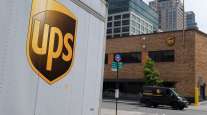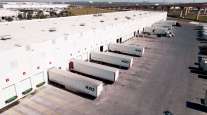UPS Reports 2nd-Quarter Growth, Plans Operational Improvements
This story appears in the Aug. 4 print edition of Transport Topics.
UPS Inc. said its second-quarter profit improved 4.5% to $1.12 billion, excluding a one-time pension charge, driven by revenue growth in every sector.
The company also outlined plans to prevent a repeat of last year’s costly holiday service delays by investing $175 million on operational improvements and lowered its full-year earnings forecast to reflect that additional spending.
Net income for the April-to-June period, including the charge, was $454 million, a 58% decrease that resulted from the $665 million expense to pay for health benefit changes in the new Teamsters contract. On a per-share basis, net income was $1.21, excluding the charge, and 49 cents including it. In the 2013 period, earnings were $1.14 per share.
Revenue increased 5.6% to $14.3 billion, reflecting 7% more domestic and international package shipments and better results in the trucking and supply chain units.
The 2014 forecast was cut to $4.90 to $5.00 per share from a previous target at the “low end” of a $5.05-to-$5.30 range. UPS still anticipates higher full-year earnings than in 2013.
During a July 29 conference call, UPS executives focused on efforts to avoid repetition of the gift delivery delays that reduced package profits by $178 million last year.
“We are planning and expecting a clean peak season for 2014,” CEO Scott Davis said on the conference call.
Among the changes being made before the holidays are adding full operations on the day after Thanksgiving, using more route optimization and other information technology tools, and increasing capacity by 5% through expansion at existing hubs.
At the same time, Chief Financial Officer Kurt Kuehn acknowledged that “we are experiencing some growing pains right now” as faster-than-expected shipment growth and rail service trouble taxed overall network performance in the quarter.
Kuehn described rail service as “very poor,” forcing the company to use more expensive alternatives such as over-the-road service.
The higher cost accompanied domestic package increases that drove up revenue 5.2% to $8.67 billion and raised profit excluding interest and taxes 3% before the one-time charge.
Ground packages rose the fastest at 8.1%, outpacing deferred and next-day air business, mostly because of more deliveries of Internet orders and increases of SurePost packages in conjunction with the U.S. Postal Service.
On the international side, revenue rose 6.2% to $3.25 billion, and profits gained 4.4%.
The supply chain and freight unit’s performance included brokerage and shipment management, as well as longhaul trucking activities. Revenue rose 6.5% to $2.35 billion, and profit excluding the charge rose 11%.
Results at UPS Freight showed $40 million higher revenue at $771 million.
All but $3 million of the increase was from less-than-truckload, where revenue rose to $672 million from $635 million. Revenue per 100 pounds of freight rose 4.1% for LTL, and tonnage gained 1.6%.
UPS doesn’t disclose specific financial results for the freight unit. However, Kuehn said margins and operating profit improved at the Freight unit.
Profitability improved more than 10% in the air and ocean brokerage sector, despite Asian pricing pressure. Management of retail, health care and distribution services showed revenue improvement of nearly 10%.
“The better-than-expected revenue growth in all segments was more than offset by lower-than-expected margins in all segments,” said a report from John Larkin, a Stifel, Nicolaus & Co. analyst.
Second-quarter results showed a 2% drop in revenue per domestic package to $9.47. Most of the decline was attributed to lower-margin Internet deliveries and SurePost service.
Pricing on the international shipments was unchanged at $18.97 per piece, as revenue growth was matched by higher operating costs.
“We aren’t looking for dramatic [pricing] changes,” Kuehn said. “This year is about investment. We are doing the right things now to invest for the future. Next year will be a different story.”
Kuehn avoided discussing specifics when asked how 2014 pricing, which is trailing last year, matched up with UPS’ long-term goal of increasing rates by 2-3% annually.
He also expressed optimism that wider use of dimensional pricing for ground shipments will enhance 2015 margins.
UPS officials also said they expected earnings per share to improve in the second half of 2014 by 12% to 17% over 2013. In last year’s second half, net income was $2.26 billion, or $2.41 per share.
Second-half improvement would be a turnaround from the first half, when net income including the charge fell 35% to $1.37 billion from $2.11 billion despite 4.1% higher revenue of $28 billion. First-half profit, excluding the charge, was 2% lower at $2.03 billion.




